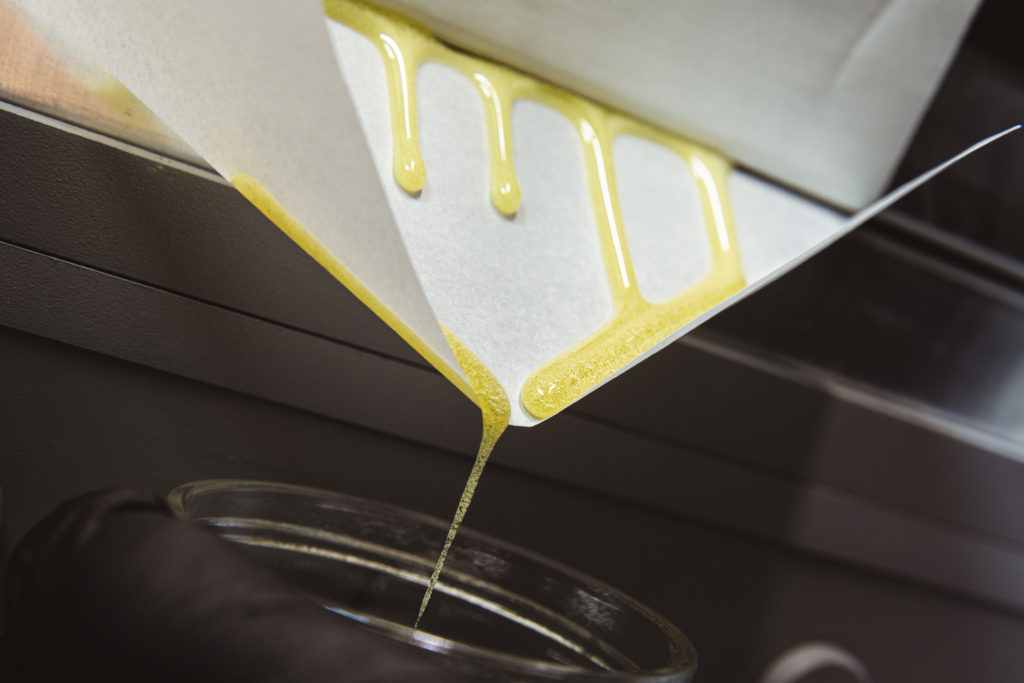Rosin makers are always looking for new ways to improve on their solventless game, and the newest trend hitting the scene is rosin jam. Cured rosin is really making a name for itself, and that’s because some intrepid solventless explorers have discovered that over time, rosin can mature like a fine wine.
The curing process usually involves rosin being collected in a sealable jar, heat treated with some variation of hot or cold temperatures, and then stored for a few weeks or longer. And, if done well, the resulting rosin jam can be one of the most flavorful and potent concentrates imaginable. So, let’s take a look at the ins and outs of curing rosin.
CURING ROSIN: JAR TECH
The first step in curing rosin is the use of jar tech. Jar tech is a simple way to collect rosin ready for curing, and involves folding your parchment paper into a funnel, which allows fresh pressed rosin oil to flow directly into a sealable heat proof glass jar.
Once your rosin has been collected in a suitable vessel, it’s time to move on to the next phase of curing: heat treatment. There are a number of different methods out there but they typically fall into two categories: hot temperature curing or cold temperature curing.
HOT CURE ROSIN
Hot curing involves applying some kind of heat cycle to your rosin, and there are a multitude of ways to achieve this. However, the most common hot cure method involves popping the jars in an oven at around 200°F for an hour or two, and then allowing them to cool.
Ultimately though, there are no hard or fast rules regarding the temperature or duration of this heat cycle, and we highly recommend that you experiment with both variables.
COLD CURE ROSIN
Conventional wisdom has it that hot temperatures tend to degrade the volatile terpene profile of your rosin, and while it’s highly debatable how much is lost with a hot cure method, many terpene conscious rosin makers prefer cold curing instead. The belief being that cold temps help preserve the delicate terpene profile of solventless rosin.
As with hot curing there’s a huge amount of variation in technique with cold curing. Some may simply use room temperatures, others may pop the jars in a refrigerator, and some even use a freezer. Again, we recommend that you experiment with both temperature and duration of your cold cure.
CURING ROSIN: THE WAITING GAME
Whether it be a hot or cold method, the true magic happens when rosin is left to sit for an extended period of time. Over the space of a few weeks or so rosin begins to separate and sweat liquid terpenes, and in turn, the cannabinoids start to recrystallize into solids.
How long you leave your rosin to sit is up to you. Typically a few weeks is seen as sufficient, but cold curing can take longer than hot, so bear that in mind. Ultimately, it’s unsure exactly what is happening with this process, but the results can be breathtaking, and that’s driving huge interest in cured solventless rosin.
Lastly, if you are interested in exploring curing techniques, we do advise that you use rosin extracted from bubble hash, as this seems to produce better results than other methods. And furthermore, the strain of cannabis you press with can make a huge difference to your final results, so be sure to experiment in this department, too.
YOU CAN CHOICE OUR ROSIN PRESS MACHINE TO MAKE YOUR OWN ROSIN -CLICK TO KNOW MORE ABOUT ROSIN PRESS MACHINE
Post time: Mar-03-2021
 86-15345081085
86-15345081085  admin@xheatpress.com
admin@xheatpress.com






